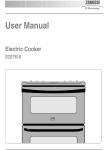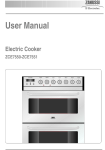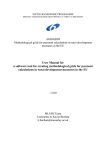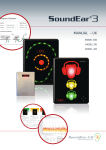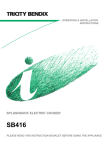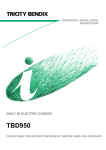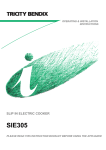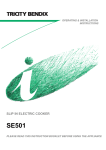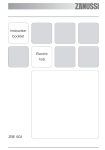Download Tricity Bendix SE310 User's Manual
Transcript
User Manual Electric Cooker SE310 Important safety information These warnings are provided in the interests of your safety. Ensure that you understand them all before installing or using the appliance. Your safety is of paramount importance. If you are unsure about any of the information in this book contact the Customer Care Department. Installation The appliance must be installed according to the instructions supplied. The installation work must be undertaken by a qualified electrician or competent person. The appliance should be serviced by an authorised Service Engineer and only genuine approved spare parts should be used. The appliance must be installed in an adequately ventilated room. If the appliance is to be placed on a base, measures must be taken to prevent the appliance from slipping from the base. This appliance is heavy and care must be taken when moving it. Do not attempt to lift or move this appliance by the handles. All packaging, both inside and outside the appliance must be removed before the appliance is used. It is dangerous to alter the specifications or modify the appliance in any way. After installation please dispose of the packaging with due regard for safety and the environment. Your local authority can arrange this. 2 Child safety Do not allow children to play with any part of the packaging. Do not allow children to sit or climb on the drop down doors. This appliance is not intended for use by children and other persons whose physical, sensory or mental capabilities or lack of experience and knowledge prevents them from using the appliance safely without supervision or instruction by a responsible person to ensure that they can use the appliance safely. Children should be supervised to ensure that they do not play with the appliance. CAUTION: Accessible parts may be hot when the grill is in use. Young children should be kept away. During use This appliance is not intended to be operated by means of an external timer or separate remote control system. This appliance has been designed for domestic use to cook edible foodstuffs only and must not be used for any other purposes. Take great care when heating fats and oils as they will ignite if they become too hot. Never place plastic or any other material that may melt in or on the oven. Do not leave the grill pan handle in position when grilling as it will become hot. Always use oven gloves to remove and replace the grill pan handle when grilling. Always support the grill pan when it is in the withdrawn or partially withdrawn position. Always use oven gloves to remove and place food in the oven. Ensure cooking utensils are large enough to contain foods to prevent spillages and boil overs. The handles of saucepans, which are smaller than the heated areas on the hob, will become hot. Ensure your hand is protected before handling the pan. During use the appliance becomes hot. Care should be taken to avoid touching the heating elements inside the oven. Ensure that all vents are not obstructed to ensure ventilation of the oven cavity. Never line any part of the appliance with foil. Always stand back from the appliance when opening the oven door to allow any build up of steam or heat to release. Never leave the appliance unattended when the oven door is open. Do not place sealed cans or aerosols inside the oven. They may explode if they are heated. Ensure that all control knobs are in the OFF position when not in use. Do not stand on the appliance or on the open oven doors. Do not hang towels, dishcloths or clothes from the appliance or its handles. Do not use this appliance if it is in contact with water. Never operate it with wet hands. At the end of the appliance’s life The symbol on the product or on its packaging indicates that this product may not be treated as household waste. Instead it shall be handed over to the applicable collection point for the recycling of electrical and electronic equipment. By ensuring this product is disposed of correctly, you will help prevent potential negative consequences for the environment and human health, which could otherwise be caused by inappropriate waste handling of this product. For more detailed information about recycling of this product, please contact your local city office, your household waste disposal service or the shop where you purchased the product. Cleaning and maintenance For hygiene and safety reasons this appliance should be kept clean at all times. A build-up of fats or other foodstuffs could result in a fire especially in the grill pan. Do not leave cookware containing foodstuffs, e.g. fat or oil in the appliance in case it is inadvertently switched on. Always allow the appliance to cool before switching off at the wall prior to carrying out any cleaning/maintenance work. Only clean this appliance in accordance with the instructions given in this book. Never use steam or high pressure steam cleaners to clean the appliance. 3 Contents For the user Important safety information Description of the appliance Getting to know your appliance Before using the appliance Rating plate Preparing to use your appliance Control panel indicator neon(s) Condensation and steam Cookware Grill and oven furniture 2 5 6 7 7 7 7 7 7 7 The sealed hotplates Before using the hotplates for the first time Using the hob Recommended saucepans Hints & tips 8 8 8 8 8 The grill Using the grill Things to note The grill pan and handle Hints & tips Grilling chart 9 9 9 9 10 11 The fan oven Using the fan oven Things to note To fit the fan oven shelves Hints & tips 12 12 12 13 13 Cooking chart 14 Roasting chart 15 Defrost feature Using defrost feature Things to note Hints & Tips 16 16 16 16 4 Care and cleaning Cleaning materials Cleaning the outside of the appliance Cleaning the control knobs and handles Cleaning the sealed hotplates and hotplate trims Things to note Cleaning the shelves and grill/oven furniture Cleaning inside the oven(s) Hints and tips Cleaning the door(s) 18 18 18 Something not working Service and spare parts Guarantee conditions 23 24 25 18 19 19 19 19 20 21 For the installer Technical details Installation instructions 26 26 To help you the following symbols will be found in the text. Hints and Tips Safety Instructions Please read the instruction book carefully before use and retain for future reference. Description of the appliance Electric slip-in single oven Control panel Grill Fan oven 5 Getting to know your appliance The control panel A B FAN OVEN GRILL BACK LEFT FRONT LEFT FRONT RIGHT BACK RIGHT 0 0 0 0 0 6 6 5 3 4 6 6 4 5 5 3 3 100 5 4 200 4 0 15 6 2 E - Grill indicator neon 1 D - Fan oven indicator neon 2 C - Hotplate controls 1 B - Grill control 2 A - Fan oven temperature control 2 Features E 1 1 240 D 3 0 C Before using the appliance Rating plate This is situated on the lower front frame of the appliance and can be seen upon opening the door. Alternatively the rating plate may also be found on the back or top of some models (where applicable). The appliance must be protected by a suitably rated fuse or circuit breaker. The rating of the appliance is given on the rating plate. Do not remove the rating plate from the appliance as this may invalidate the guarantee. Preparing to use your appliance Wipe over the base of the oven(s) with a soft cloth and hot soapy water and wash the furniture before use. We suggest that you run the oven(s) and grill for 10 – 15 minutes at maximum temperature, to burn off any residue from their surfaces. Accessible parts may become hotter than in normal use. Children should be kept away. During this period an odour may be emitted, it is therefore advisable to open a window for ventilation. Control panel indicator neon(s) The indicator neon will operate when the grill (where applicable) or oven(s) is switched on. The indicator neon will glow. It may turn on and off during use to show that the setting is being maintained. If the neon does not operate as the instructions indicate the controls have been incorrectly set. Return all controls to zero and reset following the instructions for the required setting. Condensation and steam When food is heated it produces steam similar to a boiling kettle. The vents allow some of this steam to escape. However, always stand back from the appliance when opening the door(s) to allow any build up of steam or heat to release. If the steam comes into contact with a cool surface on the outside of the appliance, e.g. a trim, it will condense and produce water droplets. This is quite normal and is not caused by a fault on the appliance. To prevent discolouration, regularly wipe away condensation and also soilage from surfaces. For your safety wall coverings at the rear of the appliance should be securely fixed to the wall. Cookware Baking trays, dishes etc., should not be placed directly against the grid covering the fan at the back of the oven. Do not use baking trays larger than 30cm x 35cm (12” x 14”) as they will restrict the circulation of heat and may affect performance. Grill and oven furniture The following items of grill and oven furniture have been supplied with the appliance. 1 grill pan 1 grill pan handle 1 grill pan grid 1 straight shelf (for grilling) 2 straight shelves (for fan oven cooking) 7 The sealed hotplates Before using the hotplates for the first time Turn the control knob to a high setting and allow the hotplate to heat, uncovered by a saucepan for 3-5 minutes. This hardens the protective coating on the hotplates and makes it more resistant to normal use. A harmless smoke will be given off from the hotplates Using the hob Hints and tips • Lift, rather than slide saucepans on and off the hob to help reduce scratches and maintain the efficiency of the hotplates. • Avoid the use of decorative covers as they can cause condensation to form on the hotplates which may lead to deterioration. • Follow any guidelines provided by the saucepan manufacturer, particularly those relating to recommended heat settings. • Turn the control knob in either direction to vary the heat setting. • Avoid using thin, badly dented or distorted saucepans. Those with uneven bases should not be used. • The highest number represents the hottest setting and the lowest number represents the coolest setting. • Never leave the hotplates ON when not covered with a saucepan. • Ensure that the hob and saucepans are clean and dry before the start of cooking to reduce cleaning. 5 1 4 2 3 6 0 Recommended saucepans Only saucepans with flat bases and close fitting lids are recommended. The saucepan base should be approximately the same size as the cooking area. Ensure that new saucepans are well scrubbed to remove edges and take off any deposits left from manufacture. Traditional round bottomed Woks must not be used even with a stand. Woks with flatbottomed bases are available and do comply with the above recommendations. 8 • Follow the cleaning instructions very closely to keep the hob looking like new. The grill CAUTION – Accessible parts may be hot when the grill is in use. Young children should be kept away. Using the grill • To operate the grill open the grill door and turn the grill to. The grill door must be left open when grilling. GRILL Things to note The indicator neon will glow. • Some smoke from fat splashes may be evident as the grill cleans itself. 0 • Never cover the grill pan or grid with foil as this can lead to grill fires. The grill pan and handle The grill pan is supplied with a removable handle. To insert the handle, press the button on the handle with the thumb and pivot slightly upwards inserting the lip into the widest part of the bracket. Move the handle towards the left, lower into position and release the button. 9 Ensure the handle is properly located. To remove the handle, press the button on the handle with the thumb and pivot the handle slightly upwards and towards the right to remove from the bracket. Protect your hands when removing the grill pan handle. Always remove the grill pan handle during grilling. To check the progress of the food being grilled, the grill pan should be withdrawn on the shelf to attend to food during cooking. Hints and tips • Most foods should be placed on the grid in the grill pan to allow maximum circulation of air to lift the food out of the fats and juices. • Adjust grid and grill pan runner position to allow for different thicknesses of foods. • Food should be thoroughly dried before grilling to minimise splashing. Brush lean meats and fish lightly with a little oil or melted butter to keep them moist during cooking. • Accompaniments such as tomatoes and mushrooms may be placed underneath the grid when grilling meats. • When toasting bread use the shelf in position 1 with the grid in the high position. • Preheat the grill on a full setting for five minutes before cooking. Adjust the heat setting and shelf as necessary during cooking. • The food should be turned over during cooking as required. 10 Grilling chart Food Bacon Rashers Beefburgers Position Grill time (mins in total) Adjust 5-6 grill 10 - 15 Chicken Joints 30 - 40 setting Chops – Lamb Pork and 15 - 20 20 - 30 Fish – Whole Trout/Mackerel grill 15 - 25 Fillets - Plaice/Cod pan 10 - 15 Kebabs grid 20 - 30 to 8 - 12 suit 10 - 20 different 20 - 30 Steaks – Rare Medium Well Done thicknesses of 6 - 12 12 - 16 14 - 20 Toasted Sandwiches food 3-4 Kidneys – Lamb/Pig Liver – Lamb/Pig Sausages The times quoted above are given as a guide and should be adjusted to suit personal taste. 11 The fan oven The fan oven is particularly suitable for cooking larger quantities of food. The advantages of fan oven cooking are: Preheating The fan oven quickly reaches its temperature, so it is not usually necessary to preheat the oven. Without preheating however, you may need to add an extra 5 – 10 minutes on the recommended cooking times. For recipes needing high temperatures, e.g. bread, pastries, scones, soufflés etc., best results are achieved if the oven is preheated first. For best results when cooking frozen or cooked chilled ready meals always preheat the oven first. Cooking temperatures Fan oven cooking generally requires lower temperatures than conventional cooking. Follow the temperatures recommended in the cooking chart. As a guide reduce temperatures by about 20°C – 25°C for your own recipes, using a conventional oven. Batch baking The fan oven cooks evenly on both shelf levels, especially useful when batch baking. Using the fan oven 200 0 15 Turn the fan oven temperature control to the required setting. 24 0 • 12 The indicator neon will glow. It may turn ON and OFF during use to show that the setting is being maintained. 0 • 100 Things to note To fit the fan oven shelves The shelves should be fitted with the straight rods uppermost on the frame and the forms towards the back of the oven. If not fitted correctly the anti-tilt and safety stop mechanism will be affected. • Hints and tips Arrange the shelves in the required positions before switching the oven on. Shelf positions are numbered from the bottom upwards. • When cooking more than one dish in the oven, place dishes centrally on different shelves rather than cluster several dishes on one shelf, this will allow the heat to circulate freely for the best cooking results. • When batch baking one type of food, e.g. Victoria sandwich cakes, those of similar size will be cooked in the same time. • It is recommended that when baking larger quantities the shelf positions should be evenly spaced to suit the load being cooked. A slight increase in cooking time may be necessary. • Do not place baking trays directly on the oven base as it interferes with the oven air circulation and can lead to base burning; use the lower shelf position. Do not place cookware and cooking pots with rough bases e.g. cast iron on the oven door as damage to the glass may occur. 13 Cooking chart The oven temperatures are intended as a guide only. It may be necessary to increase or decrease the temperatures to suit individual preferences and requirements. Food Biscuits Bread Bread rolls/buns Cakes: Small & Queen Sponges Victoria Sandwich (7”) Madeira (7)” Rich Fruit (8)” Christmas (8)” Gingerbread Meringues Flapjack Shortbread Casseroles: Beef/Lamb Chicken Convenience Foods Fish Fish Pie (Potato Topped) Fruit Pies, Crumbles Milk Puddings Pasta/Lasagne etc. Pastry: Choux Eclairs, Profiteroles Flaky/Puff Pies Shortcrust Mince Pies Meat Pies Quiche,Tarts, Flans Roasting Meat, Poultry Scones Shepherd’s Pie Soufflés Vegetables: Baked Jacket Potatoes Roast Potatoes Yorkshire Pudding: Large Individual Shelf position 180-190 200-220 200-220 160-170 160-170 160-170 140-150 130-140 130-140 Approx cook time (min) 10 - 20 25 - 30 positions 15 - 20 18 - 25 18 - 20 are not 18 - 25 1¼ - 1½h 2¼ - 2½h critical 3 - 4½h depends on size 140-150 1¼ - 1½h but ensure 90-100 2½ - 3h 170-180 25 - 30 130-140 45 - 65 that oven 140-160 2½ - 3h 180-190 1¼ - 1½h Follow manufacturer’s instructions 170-190 20 - 30 190-200 20 - 25 shelves are 190-200 40 - 50 130-140 1½ - 2h 190-200 40 - 45 evenly 190-200 30 - 35 170-180 20 - 30 210-220 25 - 40 spaced 190-200 15 - 20 190-210 25 - 35 180-210 25 - 45 when more 160-180 see roasting chart 210-220 8 - 12 190-200 30 - 40 than one is 170-180 20 - 30 180-190 1 - 1½h 180-190 1 - 1½h used 210-220 25 - 40 200-210 15 - 25 Shelf Note: Shelf positions are counted from the bottom of the oven. 14 Cooking temp (°C) Roasting chart INTERNAL TEMPERATURES – Rare : 50-60°C; Medium : 60-70°C; Well done : 70-80°C MEAT TEMPERATURE COOKING TIME 20-35 minutes per ½kg (1lb) and 20-35 minutes over Beef/ Beef boned 160-180°C Mutton/Lamb 160-180°C 25-35 minutes per ½kg (1lb) and 25-35 minutes over Pork/Veal/Ham 160-180°C 30-40 minutes per ½kg (1lb) and 30-40 minutes over Chicken 160-180°C 15-20 minutes per ½kg (1lb) and 20 minutes over Turkey/Goose 160-180°C 15-20 minutes per ½kg (1lb) up to 3½kg (7lb) then 10 minutes per ½kg (1lb) over 3½kg (7lb) Duck 160-180°C 25-35 minutes per ½kg (1lb) and 25-30 minutes over Pheasant 160-180°C 35-40 minutes per ½kg (1lb) and 35-40 minutes over Rabbit 160-180°C 20 minutes per ½kg (1lb) and 20 minutes over The roasting temperatures and times given in the chart should be adequate for most joints, but slight adjustments may be required to allow for personal requirements and the shape and texture of the meat. However, lower temperatures and longer cooking times are recommended for less tender cuts or larger joints. Wrap joints in foil if preferred, for extra browning uncover for the last 20 – 30 min. cooking time. 15 Defrost feature This function defrosts most foods faster than more conventional methods. It is particularly suitable for delicate frozen foods which are to be served cold e.g. cream filled gateaux, cakes covered with icings or frostings, cheesecakes, biscuits, scones, etc. Using defrost feature • When defrost is selected, the oven indicator neon may come ON. It will stay ON until the oven reaches room temperature and then go OFF. • It may turn ON and OFF periodically during defrosting to maintain a steady room temperature, inside the oven. 0 100 Turn the fan oven temperature control to the defrost setting. • 16 Hints and tips Place the frozen food in a single layer where possible and turn it over half way through the defrosting process. The actual speed of defrosting is influenced by room temperature. On warm days defrosting will be faster than on cooler days. 200 • The oven fan will come on. 0 • 24 Things to note 15 0 • • It is preferable to thaw fish, meat and poultry slowly in the fridge. However, this process can be accelerated by using the defrost function. Small or thin fish fillets, frozen peeled prawns, cubed or minced meat, liver, thin chops, steaks etc., can be thawed in 1 – 2 hours. • A 1kg/2¼lb oven ready chicken will be thawed in approximately 5 hours. Remove the giblets as soon as possible during the thawing process. • Joints of meat up to 2kg/4½lb in weight can be thawed using the defrost function. • All joints of meat and poultry must be thawed thoroughly before cooking. • Always cook thoroughly immediately after thawing. • Do not leave food at room temperature once it is defrosted. Cook raw food immediately or store cooked food in the fridge, once it has cooled. • Care must always be taken when handling foods in the home. Always follow the basic rules of food hygiene to prevent bacterial growth and cross contamination when defrosting, preparing, cooking, cooling and freezing foods. 17 Care and cleaning Before cleaning always allow the appliance to cool down. Cleaning materials Before using any cleaning materials on your appliance, check that they are suitable and that their use is recommended by the manufacturer. Cleaners that contain bleach should NOT be used as they may dull the surface finishes. Harsh abrasives must also be avoided. Cleaning the outside of the appliance Do not use abrasive cleaning materials e.g. Hob Brite, Brillo pads or scourers on painted or printed finishes as damage may occur. Regularly wipe over the control panel, doors and appliance sides using a soft cloth and hot soapy water. To prevent streaking finish with a soft cloth. Stainless Steel cream cleaners are abrasive and should be avoided as they may dull the surface finish. Any spillage on the stainless steel finish must be wiped off immediately. Do not attempt to remove any of the control knobs from the appliance as this may cause damage and is a safety hazard. Cleaning the control knobs and handles It is strongly recommended that only hot soapy water is used for cleaning the control knobs and handles. ANY OTHER CLEANING MATERIALS MAY DULL THE SURFACE FINISH. 18 Cleaning the sealed hotplates and hotplate trims In order to maintain the appearance of your appliance's sealed hotplates and trims, you are advised to use the recommended cleaning agents daily. If you do not allow spillages to burn on they will be much easier to clean off. Things to note The red spot in the centre of the hotplates may be removed with some abrasive cleaning agents. This is not a fault and does not affect the performance of the hotplates. For normal soilage Wipe over the hotplates and trims using a clean damp cloth then switch to a low or medium setting for a few minutes to thoroughly dry. For heavy soilage Use a clean damp cloth or scourer with a cream cleaner e.g. ‘Cif’ or a powder cleaner e.g. ‘Ajax’ on the hotplate and trims. Follow the circular grooved pattern on the hotplate when cleaning. Rinse off cleaning agents thoroughly. Dry as for normal soilage. For more stubborn marks warm the hotplate on a low setting for 30 seconds. Clean the sealed plate with ‘Ajax’ powder cleaner, ‘Cif’ or cream cleaner or a ‘Brillo’ pad. You may have to rub hard for several minutes. Rinse off cleaning agents thoroughly with a damp cloth. Switch to a low or medium setting for a few minutes until the hotplate is thoroughly dry. Cleaning the hotplate trims The stainless steel trims may become straw coloured during use. Using a proprietary stainless steel cleaner, e.g. ‘Shiny Sinks’ will help maintain a bright appearance. Alternatively a powder cleaner such as ‘Bar Keepers Friend’ may be used regularly. Cleaning the shelves and grill/oven furniture All removable parts, can be washed in the dishwasher. The grill pan, grill pan grid and oven shelves may be cleaned using a soap impregnated steel wool pad. Soaking first in hot soapy water will make cleaning easier. Cleaning inside the oven(s) The Stayclean surface on the rear oven panel should not be cleaned manually. The vitreous enamel base and sides in the grill compartment and the fan oven base and sides can be cleaned using normal oven cleaners or aerosol oven cleaners with care. Ensure that the manufacturers instructions are followed and that all parts are well rinsed afterwards. Aerosol cleaners must not come into contact with elements, the door seal, or any painted finishes as this may cause damage. 19 Hints and tips Aerosol cleaners must not be used on Stayclean surfaces. To carry out the cleaning cycle remove the oven shelves and set the oven to 220°C. It is a good idea to run the oven for an hour or two per week to ensure continued good performance from the Stayclean finish. Slight discolouration and polishing of the Stayclean surfaces may occur in time. This DOES NOT affect the Stayclean properties in any way. Use minimal, if any, extra oil or fat when roasting meat, potatoes only require brushing with fat before cooking. Extra fat in the oven during roasting will increase splashing and soilage. It is NOT necessary to add water to a meat tin when roasting. The water and the fat juices from the joint create excessive splattering during cooking – even at normal temperatures, as well as causing condensation. Covering joints during cooking will also prevent splashing onto the interior surfaces. Removing the covering for the last 20-30 minutes will allow extra browning if required. Some large joints and turkeys especially benefit by this method of cooking, allowing the joint to cook through before the outside is over-browned. 20 Cleaning the door(s) To prevent damaging or weakening the door glass panels avoid the use of the following: • Household detergents and bleaches • Impregnated pads unsuitable for non-stick saucepans • Brillo/Ajax pads or steel wool pads • Chemical oven pads or aerosols • Rust removers • Bath/Sink stain removers Cleaning between the outer and inner door glass The outer door glass is removable for cleaning. To remove the outer glass 1. 2. 3. 4. 5. Open the oven door slightly to gain access to the two cross head screws on the top of the oven door. Loosen the two screws using a Pozidrive screwdriver. Hold the door glass securely in place with one hand before removing the screws completely with the other hand. Using both hands, gently tilt the top of the door glass towards you, lift slightly to disengage the locators from the two bottom brackets. Clean the outer and inner glass using hot soapy water or Hob Brite cleaner may be used. DO NOT use Hob Brite on the Stainless Steel or painted finishes. DO NOT try to clean the foil which is inside the door. The foil is there to help keep the door cool, if it is damaged it will not work. Ensure that all parts are well rinsed and thoroughly dried before attempting to replace the outer door. 21 If the door glass panel becomes chipped or has deep scratches the glass will be weakened and must be replaced to prevent the possibility of the panel shattering. Please contact your local Service Force Centre who will be pleased to advise further. To replace the outer glass 1. 2. 3. 4. Holding the oven glass with both hands, gently place the locators into the holes of the brackets at the bottom of the oven door. Push the top of the oven glass towards the oven door, ensuring the screw location holes line up. Hold the glass in place with one hand and insert the cross head screws into the location holes with the other hand. Give the screws one turn to ensure the glass is secure. Tighten the screws positively with a Pozidrive screwdriver before closing the oven door. Do not attempt to use the oven without the glass being in place. To clean the inner glass door panels Clean the inner glass door panels using a soft cloth and hot water to which a little washing up liquid has been added. If the inner panel is heavily soiled, Hob Brite may be used. Do not use abrasive cleaning materials on the door glass. Ensure that all parts are well rinsed and thoroughly dried before attempting to replace the glass. 22 Something not working Please carry out the following checks on your appliance before calling a Service Engineer. It may be that the problem is a simple one that you can solve yourself without the expense of a service call. In-guarantee customers should make sure that the checks have been made as the engineer will make a charge if the fault is not a mechanical or electrical breakdown. Please note that proof of purchase is required for in-guarantee service calls. Problem Possible solution The grill and oven do not work. Check that the appliance has been wired in to the appliance supply and is switched on at the wall. Check that the main appliance fuse is working. If you have checked the above: Allow the appliance to cool for a couple of hours. The appliance should now be working normally. The grill does not work or cuts out after being used for a long period of time. Leave the grill door open and allow the grill to cool. After a couple of hours check that the grill works as normal. The indicator neons are not working correctly. Check that you have selected only the function you require. Ensure all other controls are in the Off position. The oven is not cooking evenly. Check that the appliance is correctly installed and is level. Check that the recommended temperatures and shelf positions are being used. The oven fan is noisy. Check that the oven is level. Check that the shelves and bakeware are not vibrating in contact with the oven back panel. The oven temperature is too high or too low. Check that the recommended temperatures and shelf positions are being used. Be prepared to adjust the temperature up or down slightly to achieve the results you want. Refer to the main oven section. 23 Service and spare parts In the event of your appliance requiring service, or if you wish to purchase spare parts, please contact your local Service Force Centre by telephoning:O870 5 929929 Your telephone call will be automatically routed to the Service Force Centre covering your post code area. For the address of your local Service Force Centre and further information about Service Force, please visit the website at www.serviceforce.co.uk. Before calling out an engineer, please ensure you have read the details under the heading "Something Not Working?". When you contact the Service Force Centre you will need to give the following details: 1. Your name, address and post code. 2. Your telephone number. 3. Clear and concise details of the fault. 4. The model and serial number of the appliance (found on the rating plate). 5. The purchase date. Please note that a valid purchase receipt or guarantee documentation is required for inguarantee service calls. For Customer Service in Ireland please contact us at the address below: Tricity Bendix Electrolux Group (Irl) Ltd Long Mile Road Dublin 12 Republic of Ireland Tel:+353 (0) 1 4090753 Email: [email protected] Customer care department For general enquires concerning your Tricity Bendix appliance, or for further information on Tricity Bendix products, please contact our Customer Care Department by letter or telephone at the address below. Customer Care Department Tricity Bendix Major Appliances Addington Way Luton Bedfordshire LU4 9QQ Tel: 0870 5 950950 (*) *calls to this number may be recorded for training purposes. 24 Guarantee conditions Products of Tricity Bendix manufacture which are not marketed by Tricity Bendix. Standard guarantee conditions European guarantee We, Tricity Bendix, undertake that if within 12 months of the date of the purchase this Tricity Bendix appliance or any part thereof is proved to be defective by reason only of faulty workmanship or materials, we will, at our option repair or replace the same FREE OF CHARGE for labour, materials or carriage on condition that: The appliance has been correctly installed and used only on the electricity supply stated on the rating plate. The appliance has been used for normal domestic purposes only, and in accordance with the manufacturer’s instructions. The appliance has not been serviced, maintained, repaired, taken apart or tampered with by any person not authorised by us. All service work under this guarantee must be undertaken by a Service Force Centre. Any appliance or defective part replaced shall become the Company’s property. This guarantee is in addition to your statutory and other legal rights. Home visits are made between 8.30am and 5.30pm Monday to Friday. Visits may be available outside these hours in which case a premium will be charged. Exclusions This guarantee does not cover: Damage or calls resulting from transportation, improper use or neglect, the replacement of any light bulbs or removable parts of glass or plastic. Costs incurred for calls to put right an appliance which is improperly installed or calls to appliances outside the United Kingdom. Appliances found to be in use within a commercial environment, plus those which are subject to rental agreements. If you should move to another country within Europe then your guarantee moves with you to your new home subject to the following qualifications: • • • • • • The guarantee starts from the date you first purchased your product. The guarantee is for the same period and to the same extent for labour and parts as exists in the new country of use for this brand or range of products. This guarantee relates to you and cannot be transferred to another user. Your new home is within the European Community (EC) or European Free Trade Area. The product is installed and used in accordance with our instructions and is only used domestically, i.e. a normal household. The product is installed taking into account regulations in your new country. Before you move please contact your nearest Customer Care centre, listed below, to give them details of your new home. They will then ensure that the local Service Organisation is aware of your move and able to look after you and your appliances. France Germany Italy Sweden UK Ireland Senlis Nürnberg Pordernone Stockholm Luton Dublin +33 (0)344622013 +49 (0)8002347378 +39 (0)800117511 +46 (0)20787750 +44 (0)8705950950 +353(0)14090753 25 Technical details Voltage: 230-240 Volts AC 50Hz Wattage: 8.8 - 9.6kW Height: 900mm Width: 500mm Depth: 600mm Weight: 50 kg This appliance complies with: European Council Directives 73/23/EEC. EMC Directive 89/336/EEC, CE Marking Directive 93/68/EEC. Energy Label Directive 2002/40/EC Installation instructions Warning: This appliance must be earthed. If your appliance has been damaged in transit, contact your supplier immediately. DO NOT attempt to install it. Your appliance left the factory fully packaged to protect it from damage. If it is delivered without packaging and damage has occurred, the manufacturer cannot accept responsibility. Contact your supplier for advice. Once the packaging has been removed the appliance should only be moved by hand. DO NOT use a sack barrow or any other aid to lift the appliance as damage may occur. Connection to the electricity supply must be carried out by a qualified electrician/competent person. 26 The electrical connection should be made using a double pole isolating switch (cooker socket) with at least 3mm contact separation in all poles. The cable must have conductors of sufficiently high crosssectional area to prevent overheating and deterioration. The recommended cross-section area is six square millimetres (6.00mm2). Fig.1. The cable should be routed away from potentially hot areas marked by X. See Fig.1. To move the appliance, open the oven door, and lift the appliance by holding inside the top of the compartment. See Fig.2. This is a type X appliance, which means it is free-standing and can be fitted with cabinets on one or both sides. Fig.2. Side walls which are above hob level should be protected by heat resistant noncombustible material and MUST NOT be nearer than 40mm to the hob side. A nominal air gap of 2mm at either side of the appliance is required to enable the appliance to be moved into position. Always ensure an air gap is maintained at hotplate level. Tiles or other forms of deep wall covering should not obscure this gap. See Fig.3. Air gap Fig.3. Overhanging surfaces or a cooker hood should be a minimum of 685mm above the hob. See Fig.4. It is important to ensure that the appliance is level after installation. Levelling feet are fitted to the appliance to accommodate uneven floors. Fig.4. 27 www.electrolux.com www.tricity-bendix.co.uk 311779300 Subject to change without notice




























